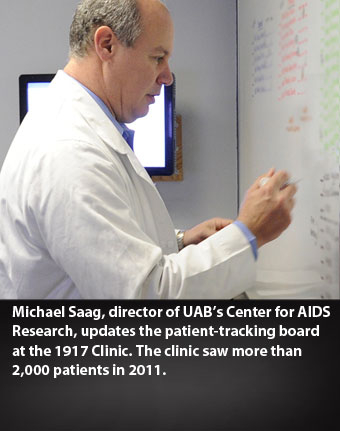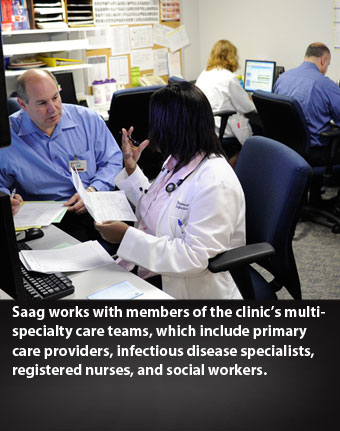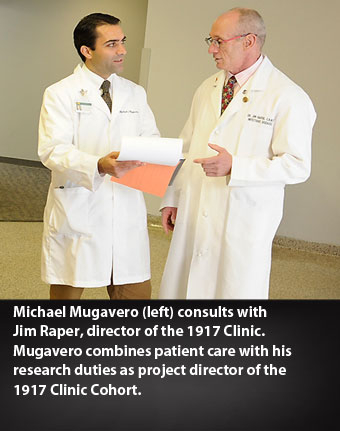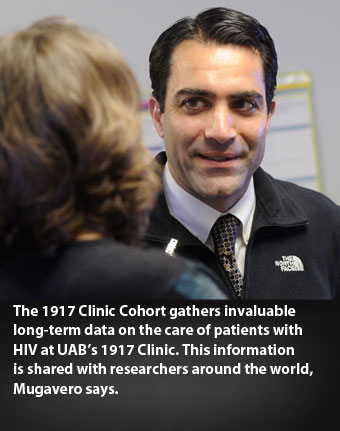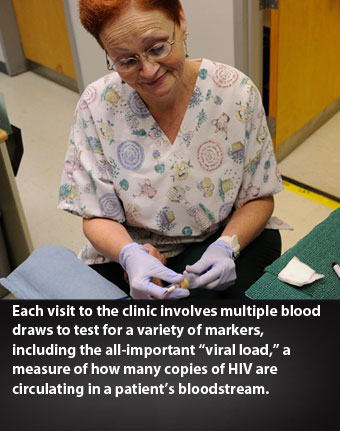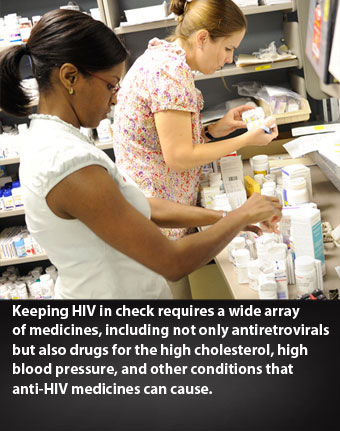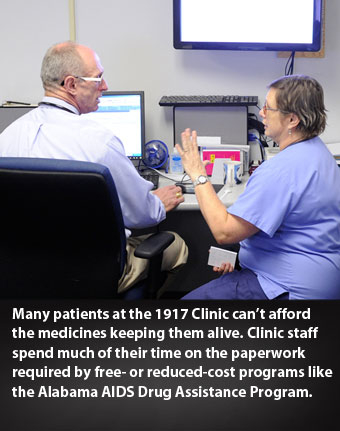UAB’s 1917 Clinic Provides Comprehensive HIV Care
By Matt Windsor
A positive test for HIV is no longer a death sentence. But it is still a life sentence for the roughly 50,000 Americans each year who discover they are infected with HIV. Even those treated at a premier facility such as UAB’s 1917 Clinic quickly find out that a diagnosis changes everything.
 “I hear young people say, ‘If I get HIV, I’ll just take a pill.’ And they have no idea what that means,” says James Raper, D.S.N., C.R.N.P., the clinic’s director.
“I hear young people say, ‘If I get HIV, I’ll just take a pill.’ And they have no idea what that means,” says James Raper, D.S.N., C.R.N.P., the clinic’s director.
Treating HIV requires “extremely expensive medicines” that must be taken every day without fail, Raper says. Wholesale costs range from $1,800 to $2,800 per month, and even patients with existing insurance pay $300 or more per month in copays. “And that’s every month for the next 50 years,” Raper notes. Today’s HIV drugs have fewer and milder side effects than previous versions, but the possibility of kidney failure and other serious complications means patients must get a checkup every six months, even if they are otherwise fine.
Each new patient at the 1917 Clinic is assigned to a multispecialty team that includes a primary provider, an infectious disease specialist, a registered nurse, and a social worker. Chaplains, counselors, dentists, nutritionists, and other specialists are available on-site as well. “Our patients could remain in our care for the next 50 years,” says Raper. “It’s important that we develop good relationships.”
Living in the Shadow
The 1917 Clinic was established in 1988 by Michael Saag, M.D., director of UAB’s Center for AIDS Research (CFAR), to provide advanced, comprehensive care for the swelling number of patients with HIV and AIDS in Alabama. Because of the stigma and fear attached to AIDS, the clinic was named after the street address for its original location on the UAB campus.
The clinic’s population has expanded rapidly in recent years, due in part to increased efforts at diagnosis and to the fact that patients are living longer. “In the 17 years that I’ve been here, we’ve gone from about 500 patients to more than 2,000 patients,” Raper says. “And we’re in the same space, with a limited number of exam rooms, doctors, and nurses.”
Many patients travel hundreds of miles to be treated in Birmingham to avoid the stigma associated with HIV infection in their hometowns. More than 400 patients at the 1917 Clinic are on Alabama’s AIDS Drug Assistance Program (ADAP), which gives the clinic the largest population of ADAP patients in the state, Raper says.
“We have five full-time social workers in the clinic plus a case worker who deal only with getting patients on medicines,” Raper says. “Twice a year, patients who receive drugs on the program have to prove that they meet the poverty requirements, which involves a great deal of paperwork.”
(Story continues beneath the slideshow)
Giving Back
With funds always tight, the only way to deal with the load “is to work longer hours and constantly be on the lookout for more efficient, more effective ways to do things,” Raper says. The 1917 Clinic was a national pioneer in the use of electronic medical records, and it continues to be a leader in this area, he notes.
“Most of the people who work here do so because they have a personal desire to be here,” Raper says. “They work long hours, often with very challenging patients. But they push on.”
The patients also give back as well, Raper points out. Many choose to take part in research studies at UAB. These include trials of new drugs, but more often patients are asked to contribute to the mundane-but-necessary process of donating samples of blood, organ tissue, and other specimens—which forms the backbone of UAB’s basic research into HIV and AIDS. “Without the contributions of the patients at this clinic, the great research that goes on at UAB would not be possible,” Raper says.
